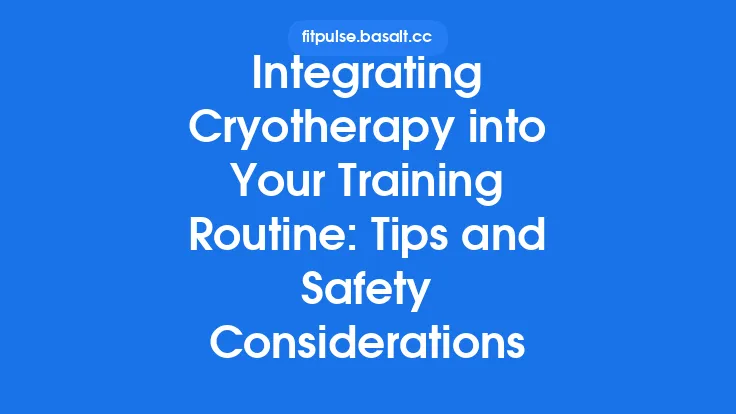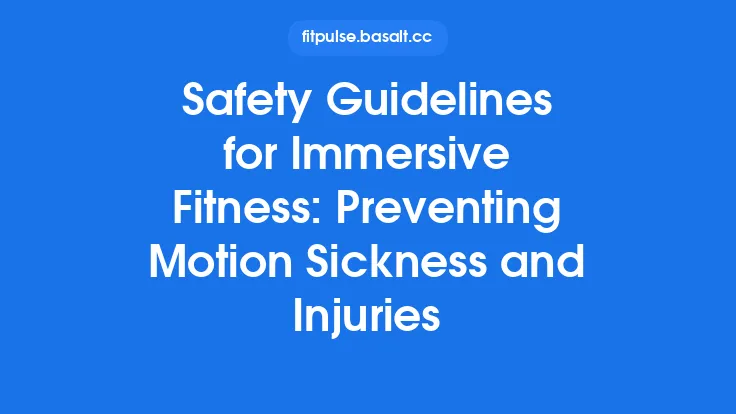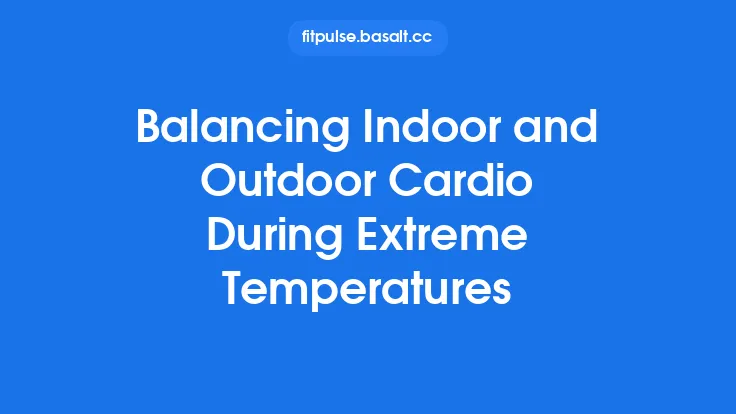Cold‑weather cardio can be exhilarating, but the frigid environment introduces unique physiological stresses that demand careful preparation. When temperatures dip below freezing, the body’s thermoregulatory and respiratory systems work overtime to maintain core temperature and oxygen delivery. Ignoring these demands can lead to frostbite, hypothermia, and cold‑induced bronchoconstriction—conditions that not only derail a workout but can pose serious health risks. This guide walks you through the science behind cold‑exposure, the warning signs to watch for, and the practical steps you can take to keep your cardio sessions safe and effective throughout the winter months.
Understanding the Cold’s Impact on the Cardiovascular and Respiratory Systems
Thermoregulation and Blood Flow
When ambient temperature falls, peripheral vasoconstriction shunts blood toward the core to preserve vital organ temperature. This protective response reduces skin blood flow, which can compromise tissue perfusion in the extremities (hands, feet, ears, and nose). Prolonged vasoconstriction, especially during sustained cardio effort, raises the risk of tissue freezing and subsequent frostbite.
Cardiac Load
Cold exposure increases systemic vascular resistance, forcing the heart to work harder to maintain cardiac output. For a given workload, heart rate may be slightly lower (the “cold‑induced bradycardia” effect) while stroke volume remains relatively unchanged, leading to a higher myocardial oxygen demand. Individuals with underlying cardiovascular disease should be particularly vigilant.
Respiratory Challenges
Inhaling cold, dry air can irritate the airway epithelium, triggering reflex bronchoconstriction—a phenomenon known as exercise‑induced bronchoconstriction (EIB) or “cold‑air asthma.” The airway cooling and subsequent re‑warming cause edema and mucus hypersecretion, which can limit airflow and precipitate coughing, wheezing, or shortness of breath.
Metabolic Shifts
Shivering thermogenesis and non‑shivering brown adipose tissue activation increase basal metabolic rate, raising caloric expenditure even at rest. While this can aid weight management, it also accelerates glycogen depletion, making energy management a critical component of cold‑weather cardio.
Recognizing Early Signs of Frostbite and Cold‑Induced Respiratory Distress
| Condition | Early Warning Signs | Progression | Immediate Action |
|---|---|---|---|
| Frostbite (Superficial) | Numbness, tingling, skin that feels “hard” or “puckered” | Skin may turn white or pale, then develop a waxy appearance | Stop activity, seek shelter, gently rewarm with body heat or warm (not hot) water |
| Frostbite (Deep) | Persistent numbness, loss of sensation, skin turns blue‑black, blisters may form | Tissue necrosis, possible loss of limb | Emergency medical care required |
| Cold‑Induced Bronchoconstriction | Tightness in chest, wheezing, coughing, sudden shortness of breath during or after exertion | Progressive airway narrowing, reduced oxygen saturation | Slow down or stop, use prescribed bronchodilator, seek medical help if symptoms persist |
| Hypothermia (Mild) | Shivering, rapid breathing, slight confusion, cold‑clammy skin | Core temperature <35 °C, shivering may cease as it worsens | Move to a warm environment, replace wet clothing, provide warm fluids if conscious |
Being able to differentiate between normal cold discomfort and the onset of pathology is essential for timely intervention.
Layering Strategies: Insulation, Moisture Management, and Breathability
- Base Layer (Moisture‑Wicking)
- Choose fabrics that transport sweat away from the skin (e.g., polyester blends, merino wool).
- Avoid cotton, which retains moisture and accelerates heat loss.
- Mid‑Layer (Insulating)
- Fleece or lightweight down provides trapped air pockets that act as thermal insulation.
- For high‑intensity cardio, a thin synthetic insulation may be preferable to avoid overheating.
- Outer Shell (Wind‑ and Water‑Resistant)
- A breathable, windproof membrane (e.g., Gore‑Tex® or similar) protects against convective heat loss while allowing moisture vapor to escape.
- Ensure the shell has ventilation zippers to regulate temperature during intense intervals.
- Extremity Protection
- Hands: Insulated gloves with a removable liner for dexterity.
- Feet: Wool or synthetic socks with a thin, moisture‑wicking liner; consider toe caps for extreme cold.
- Head/Face: A balaclava or neck gaiter that can be pulled over the mouth and nose to warm inhaled air.
- Dynamic Adjustability
- Design your outfit so that you can add or remove layers without stopping the workout. Zippers, Velcro closures, and detachable sleeves are valuable features.
Breathing Techniques to Mitigate Cold‑Air Bronchoconstriction
- Nasal Breathing: Inhaling through the nose warms and humidifies the air before it reaches the lower airways, reducing the trigger for bronchoconstriction. Practice rhythmic nasal breathing during low‑intensity warm‑ups and transition to mouth breathing only when intensity demands it.
- The “Pursed‑Lips” Method: During recovery intervals, exhale through pursed lips to maintain positive airway pressure, which helps keep small airways open.
- Pre‑Exercise Inhalation of Warm, Moist Air: Using a scarf or a specialized heat‑mask, breathe in slightly warmed, humidified air for 2–3 minutes before starting the main cardio session. This can pre‑condition the airway epithelium and blunt the reflex constriction.
- Pharmacologic Prophylaxis (When Prescribed): For individuals with known EIB, a short‑acting bronchodilator (e.g., albuterol) taken 15 minutes before exercise can prevent severe bronchospasm. Always follow a physician’s guidance.
Pre‑Workout Preparation and Warm‑Up Protocols for Cold Environments
- Active Warm‑Up (5–10 min)
- Begin indoors or in a sheltered area. Perform dynamic movements that elevate core temperature: high‑knees, butt kicks, arm circles, and light jogging. Aim for a heart rate 50–60 % of your predicted maximum.
- Targeted Limb Warm‑Up (2–3 min)
- Focus on extremities that will be most exposed. Wrist circles, ankle pumps, and gentle hand squeezes improve local blood flow, reducing the risk of peripheral frostbite.
- Gradual Exposure
- Transition to the outdoor environment gradually. Start at a slower pace for the first 5 minutes, allowing the body to adapt to the cold air while maintaining the elevated core temperature achieved indoors.
- Hydration Check
- Even in cold weather, dehydration can impair thermoregulation. Sip a small amount of warm (room‑temperature) fluid before heading out.
Hydration and Nutrition Considerations Specific to Cold‑Weather Cardio
- Fluid Temperature: Warm beverages (e.g., herbal tea) are more palatable and can raise core temperature modestly. Avoid extremely hot drinks that may cause rapid vasodilation and subsequent heat loss.
- Electrolyte Balance: Sweating in cold weather is less noticeable, but electrolyte loss still occurs. Include a modest amount of sodium (≈200–300 mg) in pre‑exercise fluids if you anticipate prolonged sessions.
- Carbohydrate Availability: Cold‑induced shivering and increased basal metabolism raise carbohydrate demand. Consume a carbohydrate‑rich snack (30–45 g) 30–60 minutes before the workout to preserve glycogen stores.
- Avoid Excessive Lipids Pre‑Exercise: High‑fat meals delay gastric emptying, which can cause discomfort when combined with the reduced gastrointestinal blood flow that occurs during cold exposure.
Monitoring and Adjusting Intensity in Real‑Time
- Heart Rate Variability (HRV): Cold stress can blunt heart rate response. Use HRV trends to gauge autonomic balance; a sudden drop in HRV may signal excessive strain.
- Perceived Exertion (RPE): Because heart rate may be misleading, rely on the Borg Scale (6–20) or a 0–10 RPE scale. Aim for a moderate RPE (4–6) during steady‑state cardio in sub‑freezing conditions.
- Skin Temperature Sensors: Wearable devices that track peripheral skin temperature can alert you to early signs of vasoconstriction. A rapid decline of >5 °C in fingertip temperature warrants a pause or layer adjustment.
- Breath Sound Monitoring: If you have a smartphone app that records breath sounds, listen for wheeze patterns. Early detection of airway narrowing allows for prompt bronchodilator use.
Emergency Response: First‑Aid for Frostbite and Respiratory Emergencies
- Frostbite Management
- Stage 1 (Frostnip): Rewarm gently with body heat (e.g., placing hands in armpits). Do not rub the area.
- Stage 2 (Superficial Frostbite): Immerse the affected area in warm (37–40 °C) water for 15–30 minutes. Do not use direct heat sources.
- Stage 3 (Deep Frostbite): Seek emergency medical services immediately. Keep the area protected from further trauma and avoid re‑warming until professional care is available.
- Cold‑Induced Respiratory Distress
- Mild to Moderate: Stop activity, move to a warm environment, and administer a prescribed rescue inhaler if available. Encourage slow, controlled breathing.
- Severe (e.g., acute asthma attack): Call emergency services. Provide supplemental oxygen if trained and equipped. Monitor for signs of hypoxia (cyanosis, confusion).
- Hypothermia Protocol
- Remove wet clothing, replace with dry layers, and apply external heat sources (warm blankets, heating packs) to the torso and groin. Avoid rapid rewarming of extremities to prevent “afterdrop” (core temperature further decreasing).
Post‑Workout Recovery and Skin Care
- Gradual Re‑Warm‑Up: After finishing the cardio session, continue moving at a low intensity (e.g., brisk walk) for 5–10 minutes to promote peripheral circulation and prevent blood pooling.
- Layer Removal Strategy: Remove outer layers first to prevent sweating from becoming trapped against the skin, which can lead to chill. Replace wet garments with dry ones promptly.
- Skin Inspection: Examine hands, feet, ears, and nose for any discoloration, numbness, or blistering. Early detection of frostbite can improve outcomes.
- Moisturization: Cold, dry air can strip skin of natural oils. Apply a barrier cream or ointment (e.g., petroleum‑based) to exposed areas to maintain skin integrity.
- Nutrition for Recovery: Consume a balanced post‑exercise snack containing carbohydrates (1–1.2 g/kg body weight) and protein (0.2–0.3 g/kg) within 30 minutes to replenish glycogen and support muscle repair.
Guidelines for Special Populations (Asthmatics, Elderly, Children)
- Asthmatics:
- Conduct a pre‑season medical review.
- Use a spacer with inhalers to improve drug delivery in cold air.
- Consider a short‑acting beta‑agonist prophylactically before each session.
- Elderly:
- Reduced thermoregulatory capacity makes them more susceptible to hypothermia.
- Keep sessions shorter (20–30 minutes) and prioritize moderate intensity.
- Ensure they have a companion or a means to call for help if needed.
- Children:
- Their surface‑area‑to‑mass ratio leads to faster heat loss.
- Supervise closely, limit exposure to 15–20 minutes, and encourage frequent breaks.
- Use child‑specific insulated gloves and hats that cover the ears.
Creating a Personal Cold‑Weather Cardio Safety Checklist
| Item | Yes/No | Notes |
|---|---|---|
| Weather Assessment – Temperature, wind chill, precipitation | ||
| Clothing Check – Base, mid, shell layers; extremity protection | ||
| Pre‑Workout Warm‑Up – Completed indoors? | ||
| Breathing Strategy – Nasal breathing plan, inhaler ready (if needed) | ||
| Hydration/Nutrition – Warm fluid, carb snack, electrolytes | ||
| Monitoring Tools – HR monitor, skin temp sensor, RPE scale | ||
| Emergency Kit – Spare gloves, blanket, first‑aid for frostbite, inhaler | ||
| Post‑Workout Plan – Cool‑down, re‑warm, skin inspection | ||
| Companion/Check‑In – Someone aware of your route and ETA |
Review this checklist before each cold‑weather cardio session. Consistency in preparation and vigilance during the workout are the cornerstones of staying safe while reaping the cardiovascular benefits of exercising in winter conditions.
By integrating these evidence‑based practices into your routine, you can confidently pursue cardio training even when the thermometer reads well below zero, minimizing the risk of frostbite and respiratory complications while maintaining optimal performance and health. Stay warm, breathe wisely, and enjoy the crisp, invigorating air that winter has to offer.





